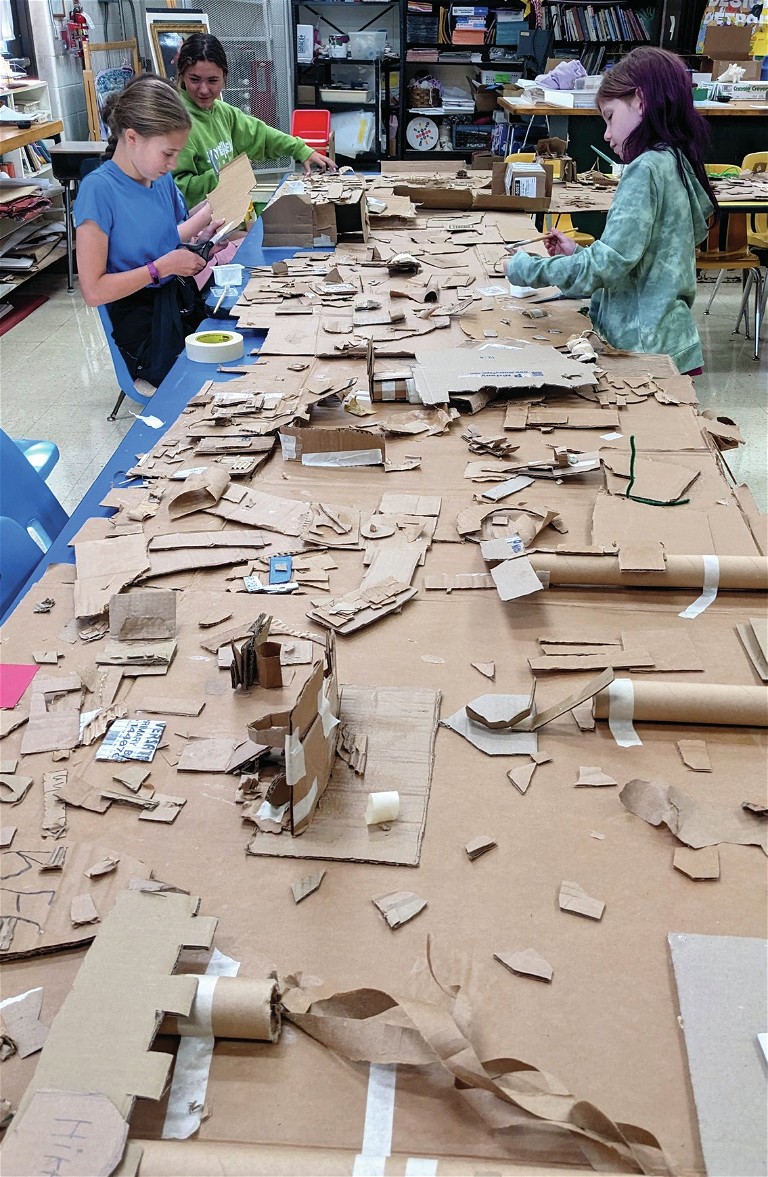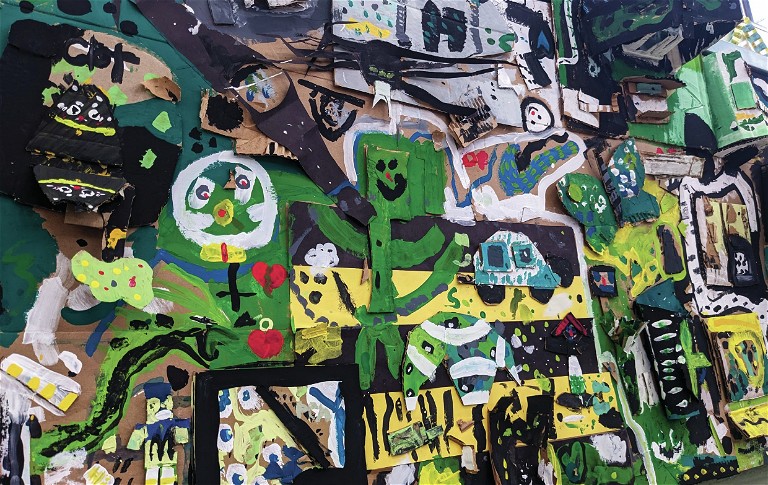EARLY CHILDHOOD / ELEMENTARY
Students reflect on the finished collaborative work through the language of drawing.
Ruth Byrne
There are many things my eightyear-old and I have in common. One example of this is that nothing irritates me more than someone telling me to take a deep breath and relax. I do enjoy taking deep breaths and engaging in ref lective activities such as yoga and doodling—I know it helps me slow down and ref lect—but when an administrator urged us to practice mindfulness and teach it to our students, it rubbed me the wrong way, and I’ve been trying to figure out why. After starting this new school year with a big, messy collaborative project, I think I’ve figured it out. Getting your mind and body to calm down is only the first step; working through what made you frustrated in the first place is what makes that mindfulness meaningful.
Outside the Vacuum
Mindfulness strategies are often taught in a vacuum (e.g., meditating when your surroundings are conveniently calm). The benefits from those soothing experiences are not always easy to apply in stressful or collaborative workspaces. Students need supportive opportunities to apply their mindfulness training so they can work through misunderstandings and conf lict, or they risk papering over problems with self-soothing techniques. I wanted to come up with a way to contextualize mindful strategies so students could practice self-regulation while talking through an uncomfortable feeling with a friend or listening to another person without jumping to conclusions.
Getting your mind and body to calm down is only the first step; working through what made you frustrated in the first place is what makes that mindfulness meaningful.
An Authentic Difficult Situation
The solution was surprisingly simple. I would give students a collaborative assignment with no obvious solution, and we would mindfully work through the difficulties we encountered with painting and conversation. Students were given just a few minutes, some cardboard, glue, and scissors to create a shared surface that would later be painted. Many students got halfway through a great idea, leaving clues for the next group to pick up on; some students completed a small, effective cardboard illustration; and all students had to entrust their artwork to students in future classes. When those future students arrived, they were perplexed by the cardboard beginnings, sometimes misinterpreting, sometimes adding on, or constructing new ideas. At this point, the visual conversation was easy, and students had no trouble finding ways to fit into or build onto the artwork.

Students create a shared cardboard surface on which subsequent classes would construct new ideas.

Students of all ages, from pre–K to grade six, shared the painting surface.
Collaboration and Discussion
Collaboration, however, isn’t always easy. Communication can be imperfect; partners may make mistakes or have ideas that differ from your own. Instead of my usual approach of combining individual artworks to create a whole, all 580 students worked on a single surface with little time or room to spare. When classes returned the following week to paint, there were gasps of excitement, happiness, horror, and despair as they discovered what had changed. While some were thrilled with the new additions, others felt their work had been destroyed, covered up, or misunderstood.
Through honest conversation, we acknowledged and worked through uncomfortable emotions to engage with the project as it was now. We referred back to artist Jason Lord’s collaboration with Peter Deligdisch, in which the artists communicated through the language of drawing rather than words. Lord and Deligdisch’s drawings ran around their cardboard space like crossing paths, mapping and overlapping spaces, and stacking visual information like an analog circuit board.
Student Solutions
I asked students to think about how these artists might have responded to an interruption in their vision without erasing each other’s work. They suggested that they could make smaller marks on top of the larger marks, paint around existing marks, and improve marks that looked unfinished. Now students were primed to connect to earlier classes by drawing paths and symbols to create unity, working with the existing marks rather than erasing them. As the cardboard filled up, their solutions became more delicate, f lexible, and thoughtful, such as adding polka dots to a bedspread or giving an alligator spiky hair.
I closed each class by asking students how they chose where to paint and what to paint. The language they used drove home the lesson objective: “I found an empty place and helped fill it in.” “I saw unfinished stripes and decided to help [that artist] finish what they started.” “I found faces and added pupils to help the art look more real.” Though many students began their session using the language of hurt and blame, they ended using the language of helping others and making improvements wherever they could.
By approaching each new problem with a mind focused on creative solutions, students had the mental space to react to other students’ contributions in a productive and supportive way. They used the mindfulness they accessed through creative problem solving to keep other people in mind.

Students painted paths and symbols to create unity, working with existing marks and honoring other studentsʼ previous designs.
NATIONAL STANDARD
Creating: Conceiving and developing new artistic ideas and work.
RESOURCES
Jason Lord: taftterrace.org
Peter Deligdisch: peterdraws.com
Ruth Byrne is an art teacher at Mansfield Elementary School in Port Murray, New Jersey. ruthcbyrne@gmail.com